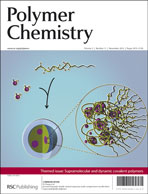A two-dimensional array of amphiphilic crosslinked networks was prepared by systematic alteration of both the composition of hyperbranched fluoropolymers (HBFPs) and the relative stoichiometries upon crosslinking with poly(ethylene glycol) (PEG). Results of physicochemical, mechanical, surface and biofouling assessment are described in full. The materials were designed to present complex surface topographies, morphologies, and chemical features over nano- and microscopic dimensions to explicitly inhibit microorganism settlement and adhesion. A multi-dimensional, tunable matrix was generated to understand and optimize the composition–structure–property relationships. The thermal properties of the crosslinked networks were analyzed by thermogravimetric analysis (TGA) and differential scanning calorimetry (DSC), where the onset of thermal degradation, overall thermal stability and phase transition temperatures could be controlled based on the formulation. Investigation of the mechanical properties of the coatings in the water-swollen state found that the Young's modulus, ranging between 10.0 and 121 MPa, was dependent on both the wt% of PEG crosslinker and chemical composition of the HBFP. This result, on average, gives Young's moduli an order of magnitude larger than that previously reported for HBFP–PEG networks. Use of atomic force microscopy (AFM) provided insight into the nanoscale topography of the networks. Interestingly, it was observed that for all networks, surface roughness increased with water swelling going from an average of 115 ± 49 nm (dry) to 214 ± 106 nm (swelled) RMS roughness. Probing the surface chemistry by optical tensiometry revealed an increase in the static water contact angle by as much as 40° after water swelling. These two findings display a counter-intuitive increase of the surface hydrophobicity. Secondary ion mass spectrometry (SIMS) confirmed migration of hydrophobic fluorocarbon units to the surface by quantifying a 24% increase in fluorine species ejected from a dry versus water-swollen surface. Selected formulations of HBFP–PEG that demonstrated complex surface features and an overall high mechanical strength were tested in biological assays and all surfaces (3 formulations × 12 replicates) completely resisted the settlement of barnacle cyprids (Balanus amphitrite). Diatoms (Navicula incerta) were two- to three-times more easily removed from the HBFP–PEG surfaces compared to a homogeneous polydimethylsiloxane elastomer (PDMSe) standard surface. In contrast, algal spores (Ulva linza) were able to colonize the surfaces and were more difficult to remove in comparison to the PDMSe standard, pointing to the challenges associated with the development of a single material that is capable of broad anti-biofouling performance.

You have access to this article
 Please wait while we load your content...
Something went wrong. Try again?
Please wait while we load your content...
Something went wrong. Try again?


 Please wait while we load your content...
Please wait while we load your content...